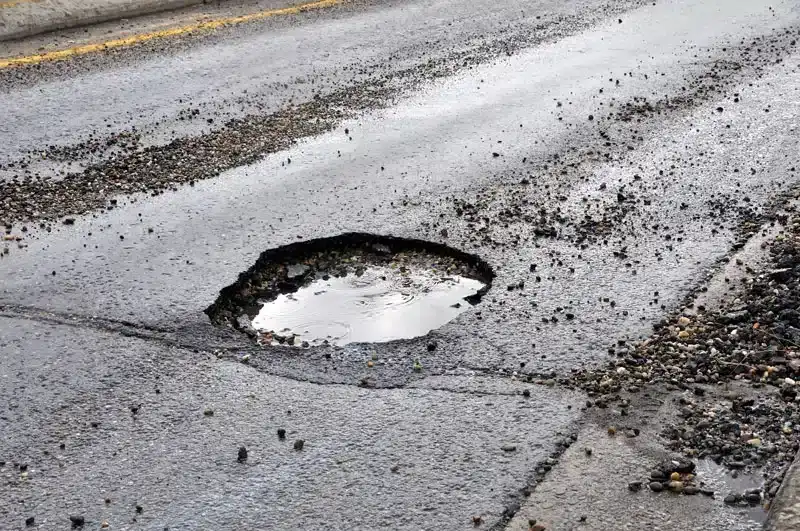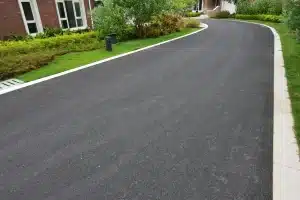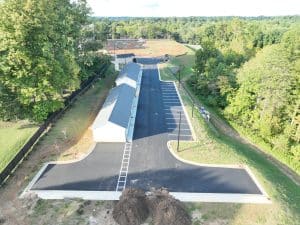Asphalt is a popular choice for driveways, parking lots, and roads due to its durability and cost-effectiveness. However, like any material, asphalt is not without its challenges. Understanding these common issues and knowing how to address them can help extend the life of your asphalt surface and save you money in the long run.
Cracking
Cracks are one of the most common problems with asphalt. They can be caused by a variety of factors, including temperature fluctuations, heavy traffic, and poor installation. Cracks not only look unsightly but can also lead to more severe damage if left untreated.
Solution: Regular maintenance is key to preventing and repairing cracks. Sealcoating your asphalt surface every few years can help protect it from the elements. For existing cracks, use a high-quality crack filler to prevent water from seeping in and causing further damage. It’s also essential to address the root cause of the cracking to prevent it from recurring.
Potholes
Potholes are not only a nuisance but can also pose a safety hazard for drivers and pedestrians. They are typically caused by water seeping into cracks and expanding when it freezes, which weakens the asphalt and creates a hole.
Solution: The best way to deal with potholes is to address them as soon as they appear. Remove any loose debris from the hole, fill it with a cold or hot mix asphalt patch, and compact it down to ensure a smooth surface. Regular maintenance and timely crack repairs can also help prevent potholes from forming in the first place.
Rutting
Rutting occurs when the asphalt surface becomes deformed under the weight of heavy vehicles, creating grooves or depressions. This can be particularly problematic in high-traffic areas and can lead to water pooling, which exacerbates the problem.
Solution: Proper installation and choosing the right asphalt mix for the expected traffic load are crucial in preventing rutting. If rutting does occur, milling the affected area and applying a new layer of asphalt can restore a smooth surface. Regularly monitoring high-traffic areas and addressing any signs of deformation early can also help mitigate this issue.
Raveling
Raveling is the gradual disintegration of the asphalt surface as the binder wears away, causing the aggregate to become loose and the surface to become rough. This can lead to further damage and a decrease in the lifespan of the pavement.
Solution: Sealcoating can help protect the binder and prevent raveling. If raveling has already begun, applying a fog seal or slurry seal can help rebind the aggregate and restore the surface. In severe cases, resurfacing the asphalt may be necessary.
Drainage Issues
Poor drainage can lead to water pooling on the asphalt surface, which can cause a range of problems, including cracking, potholes, and raveling. Standing water can also be a safety hazard, particularly in areas with heavy pedestrian traffic.
Solution: Ensuring proper drainage is essential in preventing water-related damage. This can include designing the pavement with a slight slope to direct water away, installing drainage systems such as gutters and grates, and keeping these systems clear of debris. Regular inspections can help identify and address drainage issues before they lead to more significant problems.
Fading and Discoloration
Over time, exposure to sunlight and weather can cause asphalt to fade and lose its rich, black color. While this is primarily an aesthetic issue, it can also indicate that the binder is breaking down, which can lead to other problems such as cracking and raveling.
Solution: Sealcoating not only helps protect against cracking and raveling but also helps maintain the appearance of the asphalt by providing a fresh, black surface. Regular sealcoating every few years can keep your asphalt looking new and extend its lifespan.
Environmental Factors
Asphalt is susceptible to damage from environmental factors such as extreme temperatures, UV radiation, and chemical spills. These factors can weaken the binder, causing the asphalt to become brittle and more prone to cracking and other damage.
Solution: Protective measures such as sealcoating and using UV-resistant coatings can help shield asphalt from environmental damage. For areas prone to chemical spills, using a more durable asphalt mix or applying a protective sealant can provide additional protection. Regular maintenance and prompt clean-up of spills can also help minimize damage.
Conclusion
While asphalt is a durable and cost-effective material for paving, it does come with its challenges. By understanding these common issues and taking proactive steps to address them, you can ensure that your asphalt surfaces remain in good condition for years to come. Regular maintenance, timely repairs, and proper installation are key to overcoming these challenges and maximizing the lifespan of your asphalt pavement.
If you’re facing any of these issues or have questions about asphalt maintenance, don’t hesitate to reach out to a professional paving company. They can provide expert advice and services to help you keep your asphalt in top shape.
Remember, a little prevention goes a long way in avoiding costly repairs and ensuring the safety and longevity of your asphalt surfaces.







